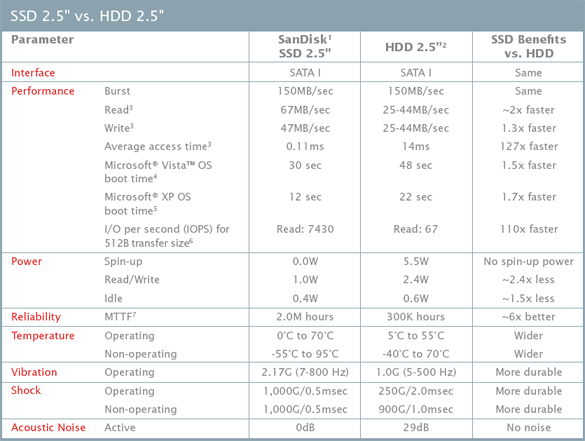Solid State Disk Drives Are Here
Flash Battles Mechanical Hard Drives
If you compare the downsides of flash memory to the drawbacks of conventional hard drives, the performance gap is obvious (slow write performance and limited write cycles for flash vs. limited mechanical robustness and noticeable latencies for hard drives). We found the following table from one of SanDisk's documents for its SSD5000 flash hard drive. It doesn't take into consideration the latest hard drive generation, nor does it cover the long access times for random write operations, but it offers a good introduction for flash SSDs:
SanDisk's comparison table isn't necessarily unbiased, because there are several items on this list that we would object to (there is no mention of write access time or available capacities and hard drive performance is not covered), but it still offers a good overview about the key differences between flash SSDs and conventional drives.
SanDisk did not consider that the latest 2.5" hard drive generation is much faster, and it would be good if the firm updated its product brochure: 5,400 RPM hard drives easily reach 50 MB/s, while 7,200-RPM notebook hard drives are as fast as 60 MB/s. While there is not too much of a difference in the write performance of hard drives compared to read performance, flash drives write clearly slower (see benchmark section). Yet, the write performance of SanDisk's SSD5000 clearly is high enough to compete with any mechanical hard drive.
Get Tom's Hardware's best news and in-depth reviews, straight to your inbox.
Current page: Flash Battles Mechanical Hard Drives
Prev Page What Is Flash Memory? Next Page Flash Vs. Flash
Patrick Schmid was the editor-in-chief for Tom's Hardware from 2005 to 2006. He wrote numerous articles on a wide range of hardware topics, including storage, CPUs, and system builds.
